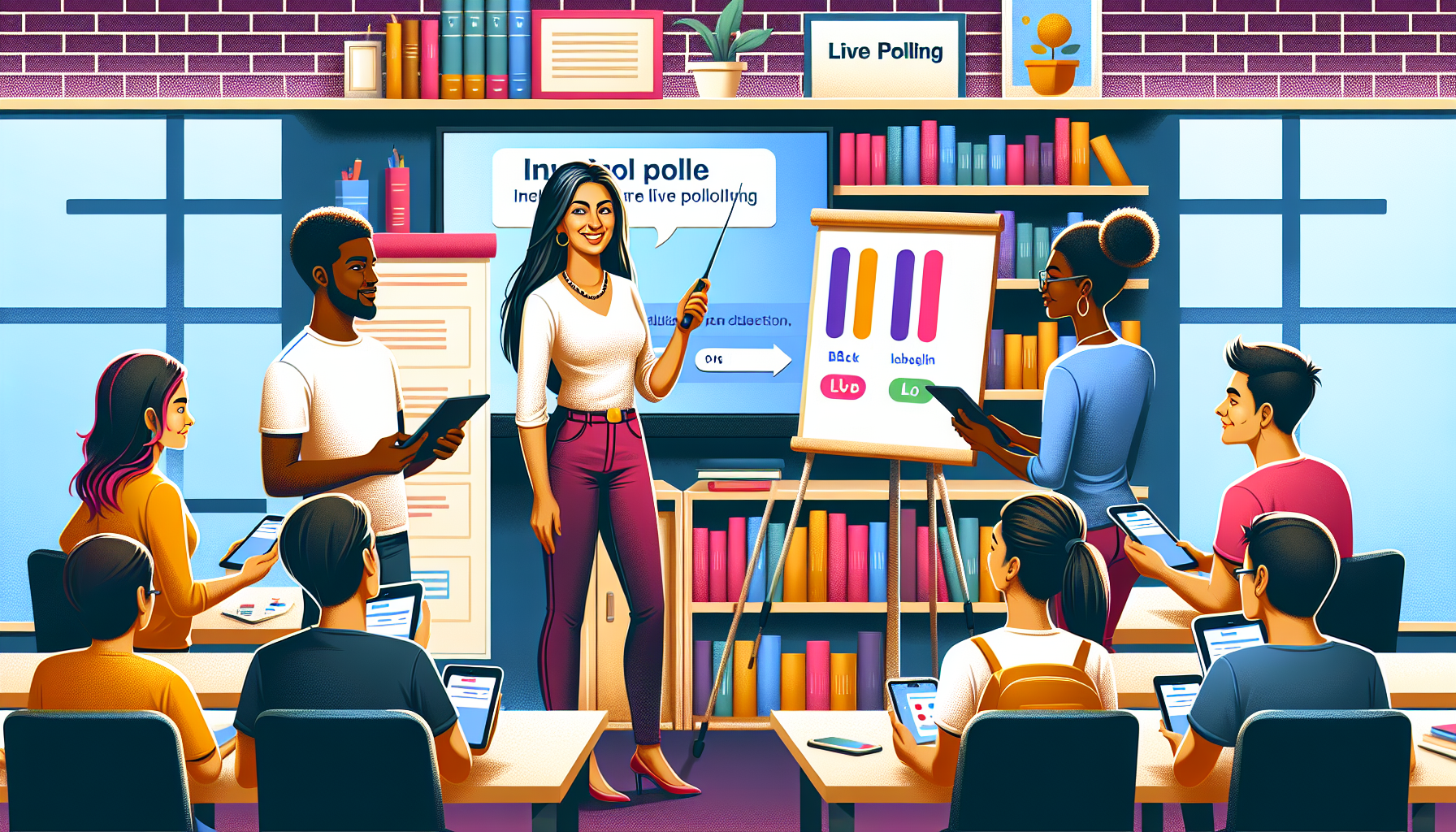It’s no secret that keeping students engaged during a class can sometimes feel like trying to herd cats. You might find yourself wondering how to spark meaningful discussions and get everyone involved. Well, you’re not alone in this struggle!
But what if I told you that using live polls could be your secret weapon? Stick around, and I’ll show you how live polling can not only enhance interaction but also provide valuable insights into your students’ understanding.
We’ll go through everything from selecting the right polling tool to crafting effective questions. Before you know it, you’ll be ready to transform your lessons and make learning more fun for everyone!
Key Takeaways
- Live polls are an effective tool to boost student engagement and gather immediate feedback.
- Select a user-friendly polling tool like Poll Everywhere or Mentimeter to integrate into your lessons.
- Introduce polls at key moments, such as before or after discussions, to inspire participation.
- Use a mix of question types to keep polls interesting, and test them beforehand.
- Analyze poll results to identify trends and adjust your teaching approach as needed.
- Share insights from polls with students to encourage greater involvement and enable targeted learning.

How to Use Live Polls in Course Delivery
Live polls are a great way to engage students and collect feedback in real-time during your course.
To start using live polls, choose a polling tool that suits your needs; tools like Poll Everywhere or Mentimeter are popular options.
Once you’ve selected your tool, integrate it into your presentation or learning platform, and guide students on how to participate.
Make sure to introduce the polls at the right moments—like before or after a topic discussion—to spark interest and gather opinions.
Benefits of Live Polls for Course Engagement
Using live polls in your course can create a more interactive learning environment, allowing students to express their thoughts anonymously.
This sense of anonymity can encourage participation, especially for students who may be hesitant to speak up in class.
Live polls also provide instant feedback, helping you gauge comprehension and adjust your teaching on the fly.
Additionally, reviewing poll results can highlight trends in student understanding, paving the way for targeted interventions where needed.
Students can see how their opinions or knowledge compare to their peers, which can foster a sense of community and encourage discussions.
Choosing the Right Polling Tool
With many polling tools available, selecting the right one depends on your specific needs and the context of your course.
Some key features to look for include ease of use, compatibility with your teaching platform, and the ability to customize poll questions.
Tools like Slido offer seamless integration with platforms like Zoom, allowing for smooth transitions during online classes.
Other options, such as Kahoot!, gamify the polling experience, making learning fun while still collecting valuable feedback.
Always consider your audience when choosing a tool; younger students may prefer platforms that incorporate graphics and animations, while adults might favor straightforward, no-frills options.
Setting Up Live Polls for Your Course
Once you’ve chosen a polling tool, it’s time to set up your first live poll.
Begin by creating your poll questions—keep them clear and concise to ensure your students understand what’s being asked.
Consider mixing question types, such as multiple-choice, true/false, or open-ended responses to keep things interesting.
Schedule the polls into your lesson plan, ideally aligning them with specific topics for maximum relevance.
Before launching the poll, run a quick test to ensure everything works smoothly, and give your students a brief walkthrough on how to use the tool.
Promote open communication about the polls; let them know you value their input and that it will directly enhance their learning experience.

Integrating Live Polls into Your Lessons
Integrating live polls into your lessons isn’t just about dropping in questions; it’s about creating a flow that enhances learning.
Start by planning when your polls will occur in your lesson. Think about placing them right after introducing a new concept to reinforce learning.
You can also use polls as a means to gauge prior knowledge before diving into a topic.
For instance, ask students to rate their understanding on a scale of 1 to 5 before your lecture on that topic, and then follow up afterward to see if their ratings changed.
Don’t forget to encourage discussion based on poll results to make the data come alive. This can lead to deeper understanding and engagement.
Additionally, consider using polls during group activities to spark conversations among students. It can be a fun icebreaker or a way to facilitate peer feedback.
For example, after a group project presentation, ask the class to vote on aspects they liked best. This not only engages the audience but also provides immediate constructive feedback.
Tips for Effective Poll Questions
Crafting effective poll questions is key to getting valuable insights. The wording and structure can make a big difference.
First, keep your questions straightforward and jargon-free to avoid confusion.
For multiple-choice questions, limit the options to 3-5 answers; too many choices can overwhelm students.
Mix question types to maintain interest, swapping between multiple-choice, scale questions, and open-ended formats for variety.
You can also consider using hypothetical scenarios in your questions to encourage critical thinking.
A good example would be asking students to choose how they would respond to a specific issue relevant to your subject matter.
Lastly, pilot test your questions with a small group if possible. This can help iron out any misunderstandings before they face the entire class.
Analyzing Poll Results to Improve Learning
Once you have set up and administered your polls, analyzing the results is where the real value starts coming in.
Begin by reviewing the data distribution. Look for trends or patterns in students’ responses that may indicate the overall understanding of a topic.
Consider using visual aids like graphs or charts to present results back to students. This makes the data accessible and helps them relate their thoughts to the larger group.
Follow up on the results by addressing any misconceptions or particularly surprising trends in the next class.
For example, if a significant number of students answered incorrectly on a conceptual question, take time to discuss and clarify during the next lecture.
You can also use the feedback to adapt your teaching style or materials. If polls reveal that certain topics are consistently unclear, you might need to revisit or reframe those lessons.
Lastly, don’t forget to share the insights with your students. Transparency about their collective understanding can motivate them to engage more actively.
Examples of Live Polls in Different Subjects
Live polls are versatile and can fit into nearly any subject. Here are a few tailored examples.
In a history class, a teacher might use a poll to ask students which event they believe had the most significant impact on modern society.
For a math class, consider using polls to pose problems that the students can solve to strengthen their skills.
In science, polling students on predictions for experimental outcomes can stir curiosity and discussion.
Language courses can benefit from polls asking which words or phrases students find most challenging, promoting focused discussions.
Finally, in social studies, poll students on their views related to current events, encouraging them to back up their positions with reasoning.
These examples show how diverse the application of live polls can be, adding richness to the learning experience across various fields.

Encouraging Student Participation with Polls
Getting students to participate in live polls can be tricky sometimes, but there are fun ways to boost engagement.
Start off by explaining the benefits of polls, emphasizing that their feedback is essential for enhancing the learning process.
When you launch a poll, create a buzz around it by introducing it as a fun activity that will impact how the class unfolds.
You can use incentives like small prizes or extra credit for active participation to motivate students.
Consider including personal or relatable questions that spark interest; this makes students feel more invested in the results.
To maintain momentum, remind students throughout the course about upcoming polls and their importance in shaping discussions.
Finally, share the outcomes of previous polls to show how their input has influenced teaching methods or course content.
Common Challenges and Solutions in Using Live Polls
Though live polls can significantly enhance course engagement, they do come with their own set of challenges.
One common issue is technical difficulties—students struggling to access the polling tool can be a real mood killer.
To address this, provide a quick troubleshooting guide or have a practice session before getting into the real polls.
Another challenge might be students not wanting to share their opinions for fear of being judged. Building a supportive classroom environment can help here.
Encourage open discussions about the importance of honesty in their responses, assuring them that all opinions are valued.
You might also face the issue of disengagement if polls feel too structured or rigid.
To combat this, mix up the types of polls you use—include humor, light-hearted questions, or current events to keep it interesting.
Finally, always seek feedback on the polling experience itself to fine-tune future polls and address any issues students bring up.
FAQs
Live polls enhance student engagement and participation, provide instant feedback, and promote active learning. They allow instructors to assess understanding and adapt lessons in real-time, making the learning experience more interactive and enjoyable.
Consider factors like ease of use, compatibility with your teaching platform, available features, and cost. Look for tools that provide real-time analytics and support various question types to enhance classroom interaction.
Common challenges include technical issues, lack of student participation, and difficulty in formulating effective questions. To overcome these, prepare in advance, encourage engagement, and utilize clear and concise polling questions.
To boost participation, create a welcoming environment, use engaging and relevant questions, and assure students that their responses are valuable. Incorporate polls as a part of assessment and reward participation where feasible.
